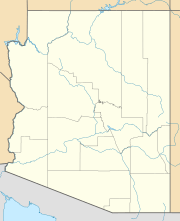Bell Rock (Arizona) facts for kids
Quick facts for kids Bell Rock |
|
|---|---|
 |
|
| Highest point | |
| Elevation | 4,919 ft (1,499 m) NGVD 29 |
| Prominence | 479 ft (146 m) |
| Geography | |
| Location | Yavapai, Arizona, U.S. |
| Topo map | USGS Sedona |
Bell Rock is a famous natural landmark located in Yavapai County, Arizona. It's a special type of mountain called a butte. You can find it just north of the Village of Oak Creek, Arizona, and south of Sedona.
This impressive rock stands tall at about 4,919 feet (1,500 meters) above sea level. It's very close to another cool rock formation called Courthouse Butte. Bell Rock is well-known for its amazing views, making it a popular spot for visitors and hikers.
What is Bell Rock?
Bell Rock is a type of landform known as a butte. A butte is like a small, isolated hill with steep sides and a flat top. It's often found in dry areas. Bell Rock gets its name because its shape looks a bit like a giant bell.
People love to visit Bell Rock for its stunning scenery. The area around it is famous for its beautiful red rock formations. These rocks glow with vibrant colors, especially during sunrise and sunset.
Exploring Bell Rock
Many people enjoy hiking around Bell Rock. There's a popular trail that's not too difficult. This trail leads to a small flat area on the northwest side of the butte. It's a great place to take pictures and enjoy the views.
If you're looking for a bigger challenge, there's also a harder trail. This path isn't marked, and it's quite tricky. It leads all the way to the very top of Bell Rock. Reaching the summit offers incredible panoramic views of the Arizona landscape.
How Bell Rock Formed
Bell Rock is made up of layers of rock that were laid down flat over millions of years. These layers are called sedimentary rock. Sedimentary rocks form when tiny bits of sand, mud, and other materials settle at the bottom of ancient seas or lakes. Over time, these layers get pressed together and harden into rock.

The rock layers of Bell Rock belong to something called the Permian Supai Formation. The Permian Period was a very long time ago, about 299 to 252 million years ago. During this time, the area where Bell Rock now stands was likely covered by shallow seas or coastal plains.
Over millions of years, wind and water slowly wore away the softer rocks around Bell Rock. This process, called erosion, carved out the distinct shape we see today. It left behind the harder rock layers, forming the tall, bell-shaped butte.


